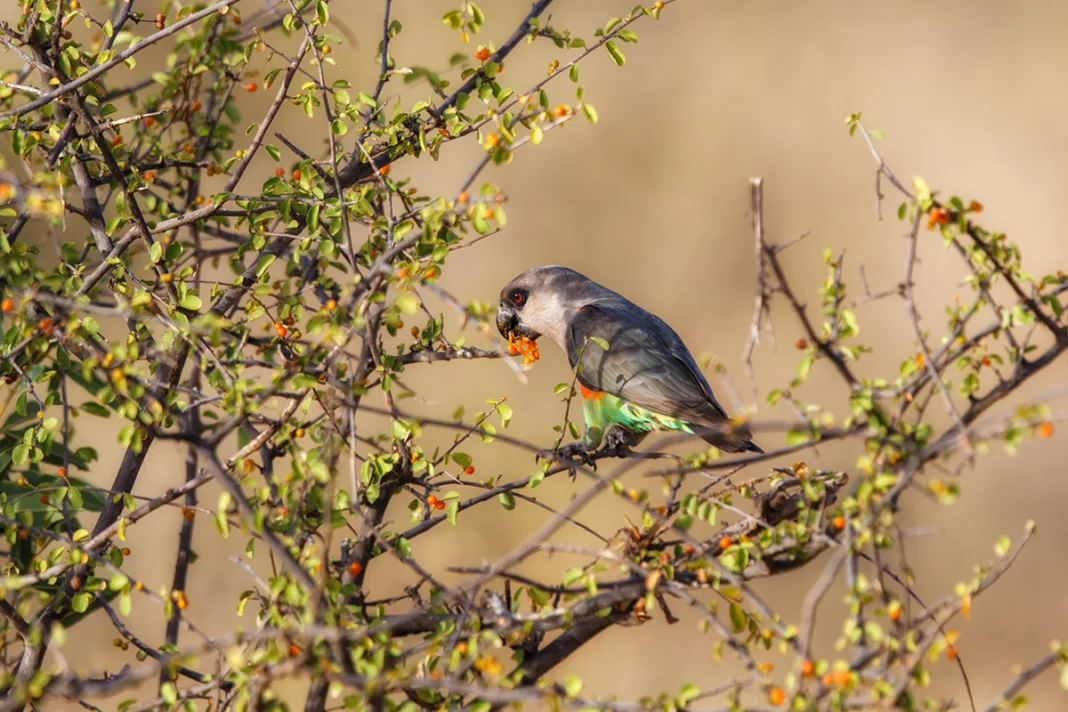Rosemary Low examines how certain species of the same genus can be sexually dimorphic, while others aren’t, as she focuses on the exquisite red-bellied parrots, a species close to her heart
WHY are some parrot species sexually dimorphic and others not? In other words, why does the plumage differ in the male and female of only a comparatively small number of parrot species? I have tried to work out reasons connected with the breeding biology of the species. In some, both sexes play an active role in rearing the chick, whereas in others, males forage for food and the female spends much more time in the nest. But this behaviour is not relevant.
Perhaps the answer is quite simple: we know that the human eye is unable to distinguish the wide range of colours that parrots detect with their UV vision. So perhaps most parrots are sexually dimorphic, but their distinguishing colours are hidden to our inferior vision.
What is interesting is in genera where some species are sexually dimorphic and others are monomorphic. The genus of African parrots Poicephalus is a good example.
In the case of the red-bellied parrot (P. rufiventris), the male is strikingly more colourful than the female. He is an extremely pretty bird, with a colour scheme that is unlike that of any other parrot. The upperparts are greyish-green and each feather is margined with grey. The head and upper breast are grey strongly tinged with orange or brown. Distinguishing features are the beautiful orange breast and underwing coverts. The thighs are green and orange, and the undertail coverts are tinged with blue.
The female differs in having the upper breast feathers the same shade as the head. The feathers of the abdomen are grey and green. This species as about as long – 22cm (8½in) – and weighs about the same – 125g (42/5oz) – as the closely related Senegal parrot (P. senegalus). In both sexes the beak and the bare skin surrounding the eye are dark grey, providing a strong contrast to the bright red eye. Note, however, that in the red-bellied parrot subspecies pallidus, which is considered doubtfully distinct by most authorities, the bare skin surrounding the eyes and also the feet are much lighter grey.
The red-bellied occurs in the central eastern part of Africa – the bit that sticks out like a thumb – in Ethiopia, Somalia, Kenya and across the border into north-eastern Tanzania. It is a fairly common and widespread species throughout most of its range.
These birds prefer dry wooded savannah and are often seen to perch on dead, bare branches, avoiding dense vegetation. Primarily a lowland species, they visit higher altitudes, as high as 2,000m (6,562ft), to feed on figs. These parrots also have a close association with baobab trees, in which they like to perch and nest.
Until the early 1980s, this parrot was very rare in aviculture. However, between 1983-1990, 16,000 were exported from Tanzania. Exports peaked in 1986 with almost 4,700 birds (Perrin, 2012) – an excessive and unsustainable number.
A zero quota was imposed from 1995-1997 and it was not long before the red-bellied parrot gradually became rarer in aviculture.
Today, the species is seldom seen or bred. It was the usual story: despite huge numbers of birds exported, only a few people bred them. Possibly many went to countries where aviculture was not well established.
My experience with this parrot occurred at Palmitos Park, Gran Canaria. The pair was on exhibit in the park. The male escaped and spent some months at liberty. When he was recaptured the pair was placed in a suspended 2m (6½ft) long cage in the breeding centre.
The female laid and incubated three-egg clutches, which appears to be normal for this species. She would leave the nest and sit innocently in the cage when anyone was in the vicinity. Incubation commenced when the second egg was laid, so chicks hatched after 30 days in the case of the first egg and 27 days for the third.
The newly hatched chicks had quite dense white down. At three weeks old, the second down (white) started to grow and by four weeks they were covered in thick, short white down, with the contour feathers just starting to show through. In one nest, the young fledged 73, 76 and 77 days after hatching.
Nest-feather is interesting. Of the three young just mentioned, two were females, making plumage comparison possible. Their breast colour was a very soft orange, that of the male being nearly as bright as the adult male. Young of both sexes have orange underwing coverts. In this case, all three had orange on the forehead, a colour which is missing in some young birds.
Females lose the orange breast colour at the first moult at about 12 months. Never again are they quite so pretty. With their dark eyes and soft colours, young red-bellied parrots are very appealing.
If acquired young, they can make good pets. However, they are liable to bond very strongly to one person, to the exclusion of all others.
Rosemary Low is a prolific author on parrots as well as an experienced all-round birdkeeper.
Find more news and articles like this on the Cage & Aviary Birds website. Subscribe to Cage & Aviary Birds magazine now.


